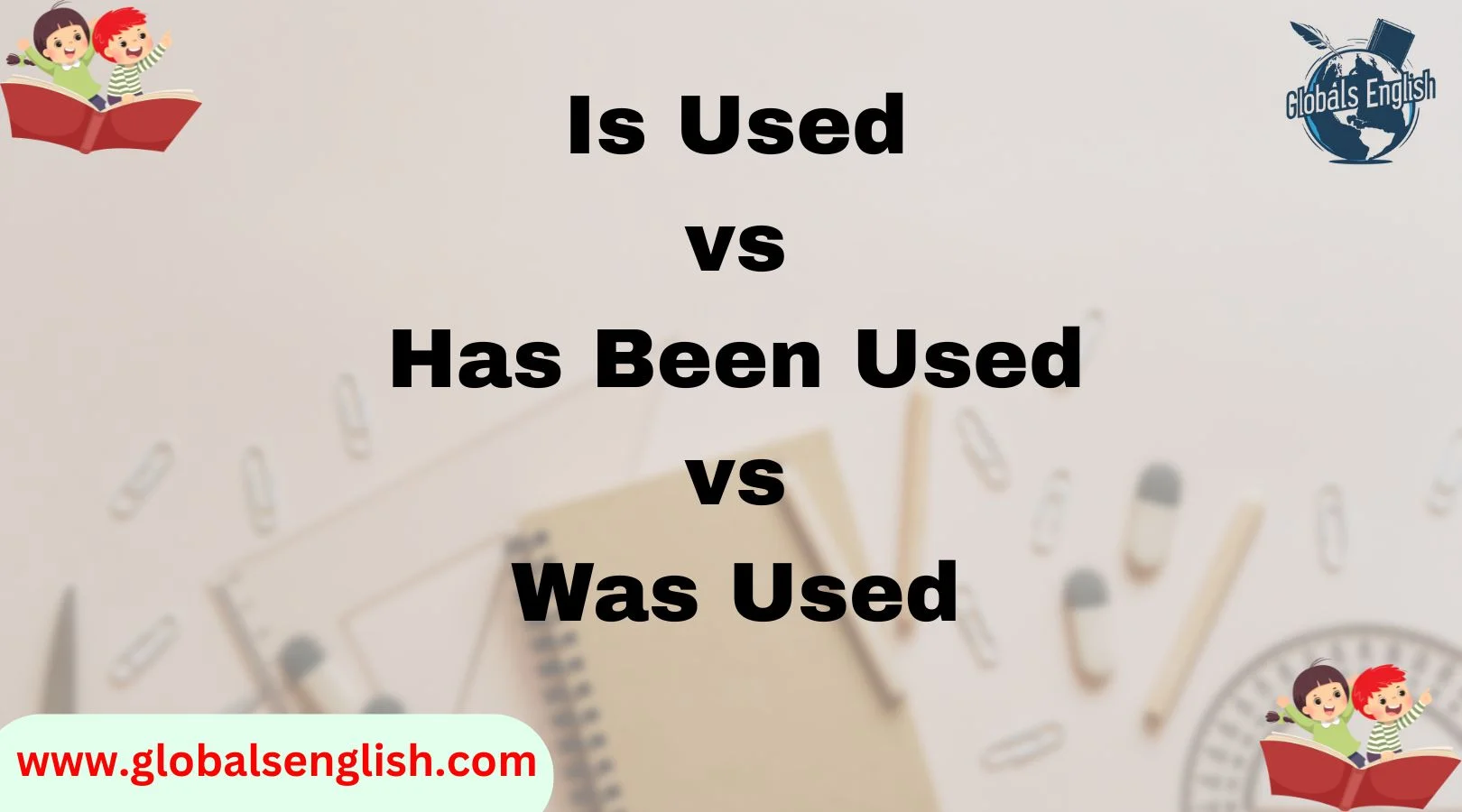Understanding the difference between ‘is used’, ‘has been used’, and ‘was used’ can significantly improve your writing and speaking. Whether you’re a student, a professional, or simply someone who loves perfect grammar, mastering these verb forms will help you convey time-related actions accurately. In this article, we’ll explore the usage of these three tenses, their differences, and real-world examples to ensure you can use them confidently.
Why Verb Tenses Matter in Communication
When you communicate in English, the way you use verb tenses can either clear up confusion or create ambiguity. Imagine you’re writing a report or telling a story, and you use the wrong verb tense to describe an action. It can lead to misunderstandings. For example:
- “The machine is used every day.” (Present, ongoing action)
- “The machine was used every day.” (Past, completed action)
- “The machine has been used every day.” (Present, but with past relevance)
Each of these sentences communicates something different, even though they might describe the same subject. So, knowing when to use ‘is used’, ‘has been used’, and ‘was used’ is crucial.
What is Verb Tense in English Grammar?
Before diving into the specifics, let’s quickly review what verb tense is. Verb tense refers to the way we express time in language—when an action took place or when it is happening.
Types of Verb Tenses in English
- Present Simple: Used for general facts or habitual actions.
- Past Simple: Describes actions completed at a specific time in the past.
- Present Perfect: Describes actions that started in the past but have relevance to the present.
In this article, we’ll focus on how the Present Simple (is used), Present Perfect (has been used), and Past Simple (was used) differ, especially when you’re describing actions in various contexts.
When to Use ‘Is Used’
The phrase ‘is used’ falls under the Present Simple tense, typically used to express habitual actions, facts, and general truths. It’s a versatile structure, often found in formal and technical writing.
Key Contexts for ‘Is Used’
- General truths: Describes something that is consistently true.
- Regular or habitual actions: Refers to something that happens regularly or routinely.
Examples:
- “This tool is used in every project.” (Refers to a tool that’s consistently used in ongoing work)
- “Electric cars are used to reduce pollution.” (A general fact)
How ‘Is Used’ Differs from ‘Has Been Used’ and ‘Was Used’
- ‘Is used’ describes something that happens regularly or is still true in the present.
- ‘Has been used’ refers to something that started in the past but is still relevant now.
- ‘Was used’ indicates a completed action in the past.
Common Mistakes to Avoid
- Don’t use ‘is used’ when referring to past events. If something happened in the past, use ‘was used’.
- Avoid overusing ‘is used’ when describing past experiences. It’s better to choose ‘has been used’ when indicating past actions with ongoing relevance.
Examples of Common Mistakes
- Incorrect: “The new software is used last year.”
- Correct: “The new software was used last year.”
When to Use ‘Has Been Used’
The Present Perfect tense, which includes ‘has been used’, is a bit more nuanced. It indicates an action that started in the past but is still relevant to the present situation.
Key Contexts for ‘Has Been Used’
- Ongoing relevance: The action or state continues to have relevance to the present.
- Recent actions: Describes an action that occurred at an unspecified time in the past but impacts the present.
Examples:
- “This method has been used for decades to increase efficiency.”
- “The strategy has been used in multiple successful campaigns.”
How ‘Has Been Used’ Differs from ‘Is Used’ and ‘Was Used’
- ‘Has been used’ highlights an action that started in the past but is still applicable or important today.
- ‘Is used’ speaks about something happening currently or as a routine.
- ‘Was used’ discusses an action that ended in the past.
Common Mistakes to Avoid
- Don’t use ‘has been used’ when referring to a regular, ongoing action. In that case, ‘is used’ is the correct choice.
- Avoid using ‘has been used’ when talking about a specific event in the past. ‘Was used’ is the proper form.
Examples of Common Mistakes
- Incorrect: “This process has been used every morning.”
- Correct: “This process is used every morning.”
When to Use ‘Was Used’
The Past Simple tense describes actions that were completed in the past. When you say something “was used”, it indicates that the action happened at a particular time in the past and is not ongoing.
Key Contexts for ‘Was Used’
- Completed actions in the past: Refers to something that occurred and ended in the past.
- Specific time reference: Often paired with a time indicator like “yesterday,” “last year,” or “in 2005.”
Examples:
- “The old machine was used during the testing phase.”
- “This method was used to solve the issue last year.”
How ‘Was Used’ Differs from ‘Is Used’ and ‘Has Been Used’
- ‘Was used’ refers to actions that ended in the past.
- ‘Is used’ focuses on the present or something that happens routinely.
- ‘Has been used’ suggests an action that started in the past but has some relevance or continuation into the present.
Common Mistakes to Avoid
- Avoid using ‘was used’ for things that are still happening or are regular. For habitual actions, use ‘is used’.
- Don’t use ‘was used’ when discussing ongoing actions with relevance to the present. ‘Has been used’ is the better choice.
Examples of Common Mistakes
- Incorrect: “The machine was used in the production process every day.”
- Correct: “The machine is used in the production process every day.”
Side-by-Side Comparison: Is Used, Has Been Used, and Was Used
Here’s a quick reference chart to help you differentiate between ‘is used’, ‘has been used’, and ‘was used’:
| Verb Form | Usage Context | Example Sentence |
| Is Used | Present, habitual, general truths | “This device is used for all major tasks.” |
| Has Been Used | Past actions with ongoing relevance | “The technique has been used in studies for years.” |
| Was Used | Completed action in the past | “The tool was used for the demonstration yesterday.” |
Practical Examples of All Three Forms
Let’s dive into some real-life scenarios to see how ‘is used’, ‘has been used’, and ‘was used’ work in action.
Business Writing
- Is Used: “This reporting system is used by all departments for tracking progress.”
- Has Been Used: “The technology has been used successfully in over 50 projects.”
- Was Used: “The software was used in last month’s product launch.”
Academic Writing
- Is Used: “This method is used in various research fields to ensure accuracy.”
- Has Been Used: “This framework has been used in multiple studies published since 2015.”
- Was Used: “The traditional technique was used in early clinical trials.”
Everyday Conversation
- Is Used: “This phone is used daily to check emails.”
- Has Been Used: “That strategy has been used to improve customer satisfaction.”
- Was Used: “The old model was used for the initial phase of the project.”
How to Choose the Right Verb Form for Your Writing
When choosing between ‘is used’, ‘has been used’, and ‘was used’, ask yourself a few questions:
- Is the action happening now? If yes, use ‘is used’.
- Does the action start in the past but have relevance now? Then, go for ‘has been used’.
- Did the action happen in the past and is now finished? Choose ‘was used’.
Use time indicators like “every day,” “since 2005,” or “last year” to help you decide which tense is appropriate.
Conclusion: Mastering Verb Tenses for Clear Communication
Understanding the difference between ‘is used’, ‘has been used’, and ‘was used’ is crucial for clear, effective communication. Each verb form provides specific information about when an action happened and how it relates to the present.
By mastering these tenses, you’ll be able to write and speak with greater precision, ensuring your audience understands exactly what you mean. Practice using these forms in different contexts, and soon, you’ll be using them like a pro!
FAQs: Is Used vs. Has Been Used vs. Was Used
1. What’s the difference between ‘is used’ and ‘has been used’?
- ‘Is used’ describes a habitual action or a general truth in the present. It’s used for something that happens regularly or is currently relevant.
- Example: “The software is used daily in the office.”
- ‘Has been used’ refers to an action that started in the past but is still relevant now. It’s used for things that have a connection to the present.
- Example: “This technique has been used for over a decade to improve results.”
2. Can I use ‘was used’ to describe a current action?
No, ‘was used’ refers to an action that happened in the past and is now finished. If you’re describing a current, ongoing, or repeated action, use ‘is used’ instead.
- Incorrect: “The machine was used every day.”
- Correct: “The machine is used every day.”
3. What’s the difference between ‘was used’ and ‘has been used’?
- ‘Was used’ describes an action that ended in the past and is no longer relevant to the present.
- Example: “The system was used for processing orders last year.”
- ‘Has been used’ highlights that an action started in the past but has relevance to the present moment or is still ongoing.
- Example: “The strategy has been used successfully in multiple countries.”
4. When should I use ‘is used’ instead of ‘was used’?
- Use ‘is used’ for something that happens regularly or as a general fact in the present.
- Use ‘was used’ when describing a specific event in the past.
Example:
- “The machine is used every morning.” (habitual)
- “The machine was used during the last event.” (past event)
5. Can I use ‘has been used’ for something that is no longer in use?
Yes, ‘has been used’ can refer to something that was used in the past but is still relevant or mentioned today. Even if something is no longer in use, ‘has been used’ can highlight its historical or ongoing importance.
- Example: “This tool has been used for years but is now obsolete.”

Emma Brooke is the author and creator behind Globals English, a platform dedicated to helping learners master the English language. With a passion for education and communication, Emma brings years of experience in language teaching and curriculum development. Her mission is to make English learning accessible, engaging, and effective for students worldwide.
